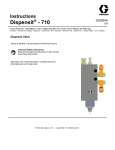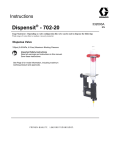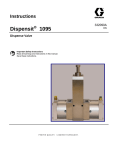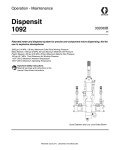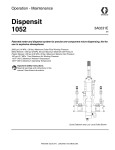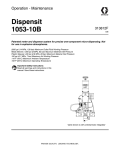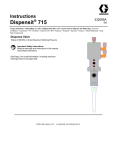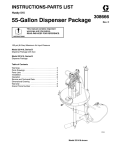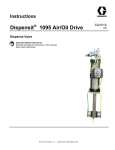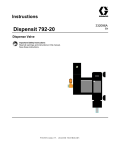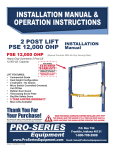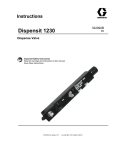Download Graco 332091A User's Manual
Transcript
Instructions Dispensit 1206 Dispense Valve Important Safety Instructions Read all warnings and instructions in this manual. Save these instructions. 332091A EN DISPENSIT® MODEL 1206 DISPENSE VALVE OPERATING AND MAINTENANCE MANUAL General Information ........................................................................ 3 Safety Information .......................................................................... 3 Illustration References ................................................................... 3 Description of Operation ................................................................ 4 Setup Procedure ............................................................................. 4 Mounting Dispense Valve ............................................................. 4 Air Controller ................................................................................. 4 Operating Procedures .................................................................... 5 Dry System Checkout ................................................................... 5 Wet System Checkout .................................................................. 5 Operation Adjustments ................................................................. 6 Periodic Maintenance ..................................................................... 6 Dispensing Needle ........................................................................ 6 Disassembly.................................................................................. 6 Model 1206 General Illustration .................................................... 7 Assembly ...................................................................................... 8 Troubleshooting.............................................................................. 9 Model 1206 Recommended Spare Parts ....................................... 10 Accessories ..................................................................................... 11 General Accessories ..................................................................... 11 Model 1206 Accessories ............................................................... 11 General Guidelines for O-rings and U-cup Seals ......................... 12 Warranty .......................................................................................... 13 GENERAL INFORMATION The Model 1206 Dispense Valve is engineered for applications which require volumetric consistency. The 1206 allows operation with material supply pressures up to 100 psi (6.9 bar). Material viscosity dispensing capabilities range from very thin material to high-viscosity epoxies and metal filled pastes with viscosities above 1,000,000 cps (1000 Pa•s). The Model 1206 ships complete with the following: Model 1206 Dispense Valve Two 3-foot (.9m) sections of Pneumatic Air Line Seal Kit Luer Lock Needle Adapter Operating and Maintenance Manual SAFETY INFORMATION This product should be used only by employees who have been given appropriate training and safety warnings as set forth in this manual. Read completely before operating. WARNING: Do not exceed 100 psi (6.9 bar) air pressure to the dispense valve. Do not exceed 100 psi (6.9 bar) material inlet pressure to the dispense valve; higher pressures may cause a hazard or serious injury. Note: The recommended pneumatic operating system pressure is 70 psi (4.8 bar) clean/dry air, if your system uses a syringe feed; do not exceed 60psi (4.1 bar) air pressure to the syringe inlet. Toxicity and flammability hazards depend upon the product being dispensed by this unit, and the user should take appropriate safety precautions as indicated on the MSDS of the product. Always wear safety glasses. ILLUSTRATION REFERENCES Throughout this manual you will find references by illustration item number to the illustrations in the manual. The references are indicated by parentheses around a number such as: (7). Illustrations represent typical valve configurations. The drawings for your exact model are inserted at the back of the manual and include the part numbers for ordering replacement parts. Page 3 DESCRIPTION OF OPERATION The 1206 Dispense Valve is a positive displacement valve that requires continuous material feed. The operation of the valve is as follows: Material enters the Dispense Valve through the material inlet port located on the metering rod/sleeve assembly and fills the dispense cavity. The start device activates the dispense cycle. To dispense, air is valved to the top fitting and vented from the bottom, lowering the metering rod, blocking the material inlet and pushing material past the spring-loaded check valve until the stroke adjustment collar stops at the top cylinder block. At that time, the material pressure becomes less and the spring-loaded check valve reseats itself, stopping the material flow. After the time delay, air is valved to the bottom fitting and vented from the top, allowing the metering rod to rise; when the rod passes the inlet, material is pushed in to fill the dispense cavity. The system is again in the normal “ready” state. SETUP PROCEDURE MOUNTING DISPENSE VALVE The1206 dispense valve can be mounted in a variety of ways. Consult the factory for an application review. AIR CONTROLLER Operation of the 1206 requires a controller that provides the following: 3 A minimum of 0.5 SCFM (2.3 cm ) of dry, unlubricated air at a minimum pressure of 70 psi (4.8 bar) and a maximum of 100 psi (6.9 bar). Time delay capability to allow the valve to cycle. Independent air pressure regulators for material reservoir and valve operation. Air supply to the material reservoir; this connection will vary depending on the type of reservoir. A start device to signal the controller to cycle the valve. Connection for an 1/8 inch (3.175 mm) ID pressure tubing for use between the controller and syringe. NOTE: If the factory supplied syringe is used, air pressure must be regulated to 60 psi (4.1bar) maximum. Page 4 OPERATING PROCEDURES DRY SYSTEM CHECKOUT This is an initial checkout to find if the system setup is complete. Conduct the dry system checkout without material in the system. Attach the pneumatic pressure lines from the dispense valve to the air supply controller. Turn on the electric and air supply. Set the air pressure to 70 psi (4.8 bar) on the system pressure gauge. Momentarily press the controller’s Dispense Valve cycling control switch. The metering rod should immediately stroke downward (the time delay must be set to allow a complete downward stroke). After the timer delay the metering rod should retract. When this happens, the system installation is correct. WET SYSTEM CHECKOUT Attach the primed material line from the reservoir to the 1/8” NPTF material inlet port on the side of the 1206 Dispense Valve. Attach the air line to the regulator and set the air pressure control to the setting required for the application. Begin with material pressure set at 15 psi (1.0 bar) and gradually increase material pressure until material feeds through the valve. Note: When utilizing a remote reservoir, the reservoir, delivery tubing, and fittings must be compatible with the material being dispensed and capable of withstanding the dispensing pressure. WARNING: Do not apply air pressure to the Dispense Valve or Feed System unless all screws, air connections, and the reservoir are in place and fastened securely. Do not exceed 100 psi (6.9 bar) material inlet pressure. Higher pressures are not required and may cause a serious hazard. If your system uses a syringe feed; do not exceed 60psi (4.1 bar) air pressure to the syringe inlet. Cycle the dispense valve several times, adjusting the material pressure until the desired shot size is repeatable. NOTE: An air bubble in the 1206 could stop thin liquids from dispensing --1) hold your fingertip over the check-valve end for a couple of cycles; 2) if this doesn’t help, point the check-valve end upward and away from people and cycle a couple of times. Page 5 OPERATING PROCEDURES OPERATION ADJUSTMENTS Adjust the Dispense Valve for proper operation as follows. See step 4 for volume adjustment. 1. Make sure that all the Dispense Valve connections are in place. 2. Connect the material for dispensing. Position a container to catch the dispensed material. Cycle the Dispense Valve until you are getting consistent dispensing (no inconsistencies in the dispensed material, symmetrical deposit shape). NOTE: Air entrapped in the material can cause inconsistencies in the dispensed material. 3. Weigh or measure a sample of the dispensed material to see if the volume is correct. 4. To adjust the volume, loosen the set screw and adjust the stroke adjustment collar on the top of the Dispense Valve. Raise the adjustment collar to increase volume and lower the collar to decrease volume. Snug the set screw. 5. Repeat the above steps until you obtain the desired shot size. 6. Adjust the time delay so that the Dispense Valve is able to dispense completely before the valve reloads. PERIODIC MAINTENANCE The model 1206 Dispense Valve has been engineered for easy cleanup. WARNING: Do not attempt any disassembly or cleaning of the unit while it is under pressure. DISPENSING NEEDLE Remove the luer lock dispensing needle by grasping at the base and twisting one-quarter turn counter clockwise. Clean with water or solvent depending on the material dispensed. A fine wire, used cautiously, will help open clogged needles. Replace if damaged or clogged. Replacement needles can be ordered for the Model 1206 Dispense Valve by specifying the proper part number seen in the Recommended Spare Parts section in this manual. DISASSEMBLY Refer to the illustration below and the drawings for your exact model at the back of this manual. WARNING: When disassembling multiple valves, do not mix parts. Metering rods are matched with their sleeves and cannot be interchanged. Some o-rings are the same size but a different color. Be sure to note which color o-ring is installed in which location. 1. Disconnect the air pressure lines and material line and remove the valve from its mounting. If your valve is equipped with option Cycle Detection, note the position of the sensors, loosen the set screws and remove the sensors. 2. Loosen the Socket Head Set Screw (18) and unscrew the Stroke Adjustment Collar (1). 3. Carefully, unscrew the Metering Rod/Sleeve Assembly (7) from the Top Cylinder Block (17). 4. Carefully, push the Piston (2) out of the Top Cylinder Block (17). Remove the O-ring (19). 5. Remove the Metering Rod head (21) from the Piston (2). 6. Take out the upper Retaining Ring (3) and remove the upper Washer (16). 7. Remove the Seal Separator Rod (6). Then remove, in order, the lower Retaining Ring (3), the lower Washer (16), and Posipak Seal (20). 8. Lift out the Seal Separator Block (5). 9. Remove the Needle Adapter (10). NOTE: Be alert to the presence of the Check Valve Spring (11) and Check Valve Poppet (13) in the Needle Adapter (10) as these parts will be loose, and can be easily lost. 10. Carefully, remove the Check Valve Spring (11) and then the Check Valve Poppet (13). 11. Remove all of the remaining seals and o-rings. Page 6 MODEL 1206 GENERAL ILLUSTRATION ALTERNATE NEEDLE ADAPTER 1 2 3 4 5 6 7 8 8A 9 10 11 Stroke Adjustment Collar Piston Retaining Ring O-Ring Seal Separator Block Seal Separator Rod Metering Rod/Sleeve Assembly O-Ring Plastic Washer (.188 rod models) O-Ring Needle Adapter Check Valve Spring Page 7 12 13 14 15 16 17 18 19 20 21 22 O-Ring Check Valve Poppet Posipak Seal U-cup Seal Washer Top Cylinder Block Socket Head Set Screw O-Ring Posipak Seal Metering Rod O-Ring (some models) PERIODIC MAINTENANCE ASSEMBLY Refer to the illustration above and the drawings in the back of this manual for your exact model. Note: Clean all valve parts with an appropriate solvent prior to reassembly. Always install new, lubricated O-rings and seals when assembling the valve. Use Krytox 203GPL (part number 84/0200-K3/11) for lubricating valve parts including seals and o-rings. Apply a very thin film of lubricant to the inside diameter surfaces of the Top Cylinder Block (17), the outside of the Metering Rod (21) and to the seals and o-rings. Check the Metering Rod/Sleeve Assembly (7) for wear and if it is worn secure a replacement before proceeding. Note: Use caution as you install new U-cup and Posipak seals so that they are not pinched or torn. Do this by making sure they are lubricated, and by tucking the lips of the seal inward before uniformly pushing them into position. 1. Insert the lubricated Posipak Seal (14) lip side down into the Metering Rod Sleeve (7). 2. Insert the Seal Separator Block (5). 3. Install, in order, the lubricated Posipak Seal (20) lip side up, the lower Washer (16), and the lower Retaining Ring (3). 4. Install the Seal Separator Rod (6), aligning the cross-hole so that the metering rod can pass through it. 5. Insert the Metering Rod (21) carefully through the lower Retaining Ring (3), the lower Washer (16), the Posipak Seal (20), the Seal Separator Block (5), Seal Separator Rod (6) and the Posipak Seal (14). 6. Install the lubricated U-cup Seal (15) lip side down into the Top Cylinder Block (17). 7. Install the upper Washer (16), then the upper Retaining Ring (3). 8. Install the lubricated O-ring (4) on the Piston (2). 9. Install the lubricated O-ring (19) into the Top Cylinder Block (17). 10. Insert the Piston (2) with O-ring (4) part way into the Top Cylinder Block (17) carefully so that the piston threads do not damage the Posipak Seal (14). Position the piston to accept the head of the metering rod. 11. Insert the Metering Rod head (21) into the Piston (2). 12. Screw the Metering Rod/Sleeve Assembly (7) into the Top Cylinder Block (17). 13. Install the lubricated O-ring (9) on the Metering Rod/Sleeve Assembly (7). 14. Install the lubricated O-ring (12) carefully over the threads of the Needle Adapter (10). Note:If the valve has the alternate needle adapter, install the outside O-ring (22). 15. Insert the lubricated O-ring (8) into the Metering Rod/Sleeve Assembly (7). Use a blunt tool to seat the o-ring firmly. Note: For .188 diameter rod models, first insert the Plastic Washer (8A) into the Metering Rod/Sleeve Assembly (7), followed by the O-ring (8). Then, use a blunt tool to seat the o-ring and washer firmly. 16. Insert the Check Valve Poppet (13) into the Check Valve Spring (11). Insert the check valve poppet/spring assembly into the Needle Adapter (10). 17. Screw the needle adapter/check valve spring/poppet assembly firmly into the Metering Rod/Sleeve Assembly (7). 18. Screw on the Stroke Adjustment Collar (1). 19. Tighten the Socket Head Set Screw (18). 20. Mount the valve and connect the air lines. If your valve is equipped with optional cycle detection, install the sensors and tighten the set screws. The model 1206 Dispense Valve is now ready to be placed back into service. Page 8 TROUBLESHOOTING Review the symptoms below for operating difficulties. With each problem there are one or more possible causes to investigate. NOTHING HAPPENS - If absolutely nothing happens when trying to cycle the Dispense Valve, check the electric and pneumatic power. Check the foot switch or cycle start switch for proper connection. HEAD CYCLES, NOTHING DISPENSED - (1) Check to see that there is enough air pressure to the reservoir, and to the Dispense Valve 70 psi (4.8 bar). - (2) Check to see that the Stroke Adjustment Collar (1 in the illustration) cycles properly. - (3) Perhaps material has “set up” in the reservoir or needle path; examine and clear or replace as necessary. - (4) An air bubble could be near the check valve. Cover the check-valve end with fingertip and cycle; or point check-valve end UP and cycle. - (5) Remove the check valve and inspect the seat and spring. IRREGULAR VOLUME DISPENSED - Faulty material will cause irregular dispensing. The material must be a smooth (homogeneous) mixture, without any air trapped in it. A second cause could possibly be that the material is not filling the metering rod chamber fully and in time. Check the reservoir pressure; it may be too low for the type of material being dispensed and/or the cycle time may be too fast. Cycle time is a function of the air supply controller. To adjust, follow the directions found in the controller operating manual. SLOW OR SLUGGISH CYCLE TIME - This may be due to inadequate lubrication of the piston walls. Refer to the Periodic Maintenance section of this manual. HEAD DROOLS OR OOZES - This can result from air trapped in the material being dispensed, or worn seals. First, check the valve seals for excessive wear. Seal kits are available and the proper kit for your valve is noted on the assembly drawing. Refer to the Periodic Maintenance section of this manual. NOTE: If this is a .188 inch rod diameter valve, be sure that the plastic washer and o-ring above the outlet check valve is firmly seated. DISPENSE VALVE LOCKS UP - First, check to see that you are using unlubricated air; It is possible for oil to build up in the valve piston when using lubricated air. Refer to the Periodic Maintenance section of this manual. Page 9 MODEL 1206 RECOMMENDED SPARE PARTS Note: These parts are routine supply items or wear parts not covered by warranty for normal wear. Quantity Description Part Number 1 1 1 1 1 1 ** SEAL KIT,1206 1206,METERING ROD/SLEEVE ASSY ASSY,CHECK VALVE/LUER LOCK OUTLET 1206,SPRING CAP,CHECK VALVE,SS SPRING,COMP,.180 ODX.380LG,80.80LB/IN,SS FINGER SNAP LUER-LOCK RING KRYTOX 203GPL ASSEMBLY LUBRICANT see assembly drawing for part number see assembly drawing for part number see assembly drawing for part number A2000262 I1000034 J7000024 84/0200-K3/11 Luer Lock Hub Replacement Needles for Single Needle Block Models Quantity ** ** ** ** ** ** ** ** ** ** Needle length shown is length projecting from LL hub. Other lengths available. Description Needle Part Number Needle Sampler Package, 10 each of 14, 16, 18, 20 and 22 E4000025-50 Needle,LL,14 ga.x ½”, Pack of 50 * Needle,LL,14 ga.x 1”, Pack of 50 Needle,LL,15 ga.x ½”, Pack of 50 Needle,LL,16 ga.x ½”, Pack of 50 * Needle,LL,18 ga.x ½”, Pack of 50 * Needle,LL,19 ga.x ½”, Pack of 50 Needle,LL,20 ga.x ½”, Pack of 50 * Needle,LL,22 ga.x ½”, Pack of 50 * Needle,LL,23 ga.x ½”, Pack of 50 E4000001-50 E4000014-50 E4000004-50 E4000088-50 E4000006-50 E4000008-50 E4000009-50 E4000011-50 E4000024-50 Note: Additional Replacement Needles sizes are available, consult factory. * Needles are included in Needle Sampler Package ** The quanity or needle size may vary for your application. Page 10 ACCESSORIES GENERAL ACCESSORIES Graco offers a full line of standard and custom accessories for your dispensing needs including: Valve Controllers Syringe Feed Systems Cartridge Retainers and Pressure Reservoirs Titan 200 High Pressure Cartridge Feed Systems Transfer Pump Feed Systems for 1, 5 and 55 gallon containers Single and Multi-Needle Blocks customized for your application Mounting Bases and Brackets Consult your Dispensit dealer or the factory for details. MODEL 1206 ACCESSORIES Cycle Detection The cycle detection option for the 1206 lets your controller act upon detection of valve stroke cycle completion by use of a fiber optic sensor. Item A5010014 A5010042 Description Cycle Detection, PNP sensor type Cycle Detection, NPN sensor type On Board Syringe Feed Assemblies Syringe feed assemblies can be mounted directly to the 1206 and include one empty syringe, a syringe adapter, syringe clamp and receiver cap. Item A2010088 A2010082 Description 10 cc Syringe Feed Assembly 30 cc Syringe Feed Assembly Page 11 GENERAL GUIDELINES FOR O-RINGS AND U-CUP SEALS Sizes and materials of construction for O-rings and U-cup seals are selected by Graco Inc. based on compatibility with the chemicals to which they will be exposed. Solvents that may remove residual chemicals often have negative effects on the mechanical properties of O-rings and seals. O-Ring Guidelines Always replace an O-ring with the identical one in size, durometer hardness, type and material of construction. Always be alert to the location and size of each O-ring as many look alike and be careful not to mix them. Often similar sizes may be used in various locations on the equipment and if replaced incorrectly, the equipment may not function properly. Refer to the Machine Operation and Service Manual for the correct part number of all O-rings used throughout the equipment and replace them with factory approved parts only. Re-use of O-rings is not recommended. Only re-use O-rings as a last resort. If you must re-use them, be sure that they are clean, have no cuts or flat spots and contain NO foreign material. Also, be sure not to soak them in solvent for extended periods as this can cause deterioration of the O-ring. Always replace O-rings that are cut, nicked, or distorted in shape or cross-section. Always apply a very thin film of Krytox 203GPL lubricant, item 84/0200-K3/11, to the entire surface of the oring before installation. Avoid excessive lubrication. If installing O-rings over threads on a shaft or across sharp edges, roll or push the O-ring carefully into place being careful to avoid cutting or nicking it. Avoid stretching the O-ring too much as it may not return to the proper size. Do not use any sharp tools or objects to install O-rings U-cup Seal Guidelines Always replace a U-cup seal with the identical one in size, durometer hardness, type and material of construction. Always be alert to the location and size of each U-cup seal as many look alike and be careful not to mix them. Often similar sizes may be used in various locations on the equipment and if replaced incorrectly, the equipment may not function properly. Refer to the Machine Operation and Service Manual for the correct part number of all U-cups used throughout the equipment and replace them with factory approved parts only. Always apply a very thin film of Krytox 203GPL lubricant, item 84/0200-K3/11, to the inner and outer lips of the seal before installation. Re-use of U-cup seals is not recommended. Only re-use U-cups as a last resort. If you must re-use them, be sure that they are clean, have no cuts or flat spots and contain NO foreign material. Also, be sure not to soak them in solvent for extended periods as this can cause deterioration of the seal. Always replace U-cups that are cut, have flat spots, are distorted in shape or are damaged in any manner. Always be alert to the proper orientation of the sealing lips and re-install them in the same direction as shown on the specific equipment assembly drawing. The U-cup seals are intended to seal in only one direction and if installed incorrectly, chemical leakage through the U-cup can occur. Whenever possible, push the back side of the seal over the shaft to protect the inner and outer lips. If this is not possible, carefully tuck the lip in to avoid rolling it back or cutting it. If installing over sharp edges, slide the seal carefully into place to avoid cutting it. Do not use any sharp tools or objects to install U-cups. Page 12 Graco warrants all equipment referenced in this document which is manufactured by Graco and bearing its name to be free from defects in material and workmanship on the date of sale to the original purchaser for use. With the exception of any special, extended, or limited warranty published by Graco, Graco will, for a period of twelve months from the date of sale, repair or replace any part of the equipment determined by Graco to be defective. This warranty applies only when the equipment is installed, operated and maintained in accordance with Graco’s written recommendations. This warranty does not cover, and Graco shall not be liable for general wear and tear, or any malfunction, damage or wear caused by faulty installation, misapplication, abrasion, corrosion, inadequate or improper maintenance, negligence, accident, tampering, or substitution of nonGraco component parts. Nor shall Graco be liable for malfunction, damage or wear caused by the incompatibility of Graco equipment with structures, accessories, equipment or materials not supplied by Graco, or the improper design, manufacture, installation, operation or maintenance of structures, accessories, equipment or materials not supplied by Graco. This warranty is conditioned upon the prepaid return of the equipment claimed to be defective to an authorized Graco distributor for verification of the claimed defect. If the claimed defect is verified, Graco will repair or replace free of charge any defective parts. The equipment will be returned to the original purchaser transportation prepaid. If inspection of the equipment does not disclose any defect in material or workmanship, repairs will be made at a reasonable charge, which charges may include the costs of parts, labor, and transportation. . Graco’s sole obligation and buyer’s sole remedy for any breach of warranty shall be as set forth above. The buyer agrees that no other remedy (including, but not limited to, incidental or consequential damages for lost profits, lost sales, injury to person or property, or any other incidental or consequential loss) shall be available. Any action for breach of warranty must be brought within two (2) years of the date of sale. . These items sold, but not manufactured by Graco (such as electric motors, switches, hose, etc.), are subject to the warranty, if any, of their manufacturer. Graco will provide purchaser with reasonable assistance in making any claim for breach of these warranties. In no event will Graco be liable for indirect, incidental, special or consequential damages resulting from Graco supplying equipment hereunder, or the furnishing, performance, or use of any products or other goods sold hereto, whether due to a breach of contract, breach of warranty, the negligence of Graco, or otherwise. The Parties acknowledge that they have required that the present document, as well as all documents, notices and legal proceedings entered into, given or instituted pursuant hereto or relating directly or indirectly hereto, be drawn up in English. Les parties reconnaissent avoir convenu que la rédaction du présente document sera en Anglais, ainsi que tous documents, avis et procédures judiciaires exécutés, donnés ou intentés, à la suite de ou en rapport, directement ou indirectement, avec les procédures concernées. For the latest information about Graco products, visit www.graco.com. 612-623-6921 contact your Graco distributor or call to identify the nearest distributor. 1-800-746-1334 330-966-3006 • Minneapolis Belgium, China, Japan, Korea • www.graco.com •














